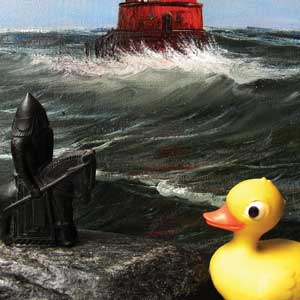|
NEWS NOTES
Oceanography
Voyage of the ducks
| Washed overboard during a 1992 storm in the Pacific, thousands of rubber duckies and other floating toys are expected to land on the shores of the United Kingdom this year, completing their epic journey around the world. |
After a 15-year epic ocean voyage that took them halfway around the world, the last of an intrepid armada of cute plastic bath toys is finally washing up on shore in the United Kingdom, oceanographers say.
In January 1992, thousands of yellow duckies, green frogs, blue turtles and red beavers, bound for the United States from China, washed overboard during a storm in the eastern Pacific Ocean. Scientists quickly recognized the serendipity of the situation: Adrift on the wide sea, the bath toys known as “Friendly Floatees” could become invaluable in tracking the direction and speed of the world’s ocean currents.
Friendly Floatees are hardly the only floating freight lost at sea to be used as data points in models of ocean currents and surface drifting. In addition to the long-used “drift bottles,” which contain a return address and a request for the finder to include where and when the bottle was found, boxes containing everything from Legos to bottles of wine to running shoes have washed overboard and become a part of science. In 1990, for example, some 60,000 shoes en route from Korea to the United States were lost during a storm. Hundreds ended up in British Columbia, Washington and Oregon, while some shoes continued southward, leaving their footprints in Hawaii two years later.
As it turns out, the duckies and their friends also took varying routes around the world. Of the original 29,000 toys set free that stormy night, 19,000 headed south, with some appearing on the coasts of Indonesia and Australia, while others crossed the southern Pacific to wash up on the coast of western South America months later.
Meanwhile, roughly 10,000 of the toys drifted north toward the Bering Strait, becoming caught in the Subpolar Gyre between Alaska and Siberia. Some of the toys circled all the way down to Japan, and then back up to Alaska, traveling at a rate of about 11.1 kilometers per day, according to retired oceanographer Curtis Ebbesmeyer, formerly of the University of Washington in Seattle, who has tracked the toys since they went overboard. After several months, hundreds of the ducks bobbed ashore in Canada and Alaska, but a few hardy others continued northward, only to become frozen in the Arctic pack ice.
Their journey did not end there, however. Moving with the ice, they traveled slowly eastward across the Arctic Ocean to the Atlantic. By 2000, they had reached the North Atlantic and began to be freed from the ice as they drifted south once more. In 2003, the U.S.-based First Years company, which initially commissioned the ducks, offered a $100 savings bond to residents of Iceland, Canada or England in return for a recovered duck (or frog, beaver or turtle).
Now, scientists say the sea voyage is finally over for the rubber duckies that made oceanography so much fun. Ebbesmeyer, who has followed the toys throughout their 27,400-kilometer voyage, thinks that the last of the toys are destined to get caught in Atlantic currents and wash up on English beaches, he told the U.K. Daily Mail on June 27. “Cornwall and the Southwest will probably get the first wave of them,” he said. Ebbesmeyer maintains a Web site for duck discoverers to contact him (http://beachcombersalert.org/).
Links:
FrizzText's photos
Beachcombers' Alert

 Subscribe
Subscribe



